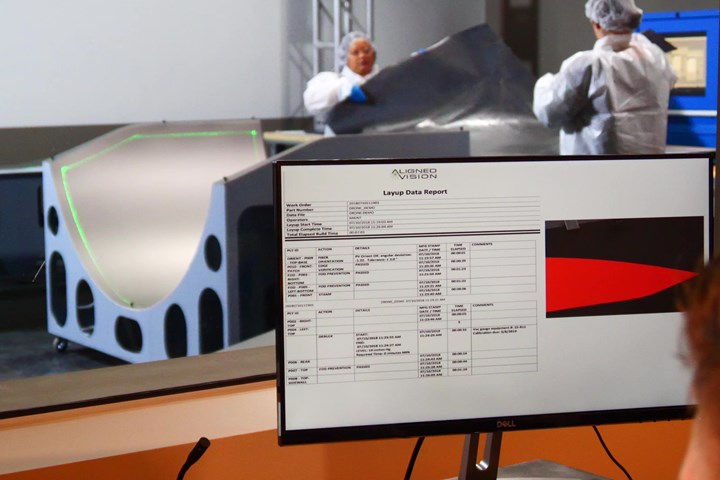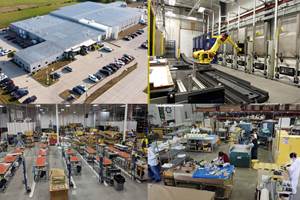Valuable data: From travelers to the as-built digital twin
Taking advantage of the electronic record proves to be of significant value to composite fabricator’s record-keeping process.

Source | Aligned Vision
When it comes to record-keeping, I have noticed a troublesome correlation, one that is true of the composites industry as much as it is of many other lines of work: The further one’s responsibilities are from the actual task of record-keeping, the more one values the resulting records. Some notable examples: The police officer working a case versus the attorney responsible for taking the case to court; the accounts receivable clerk versus the business owner; and the composites layup operator versus the manager or manufacturing engineer.
It makes sense. The layup operator is focused on getting the part built, and record-keeping is secondary. But for the composites manager or engineer, accurate build records provide both the requisite traceability for each component and a wealth of information that can be used to improve process efficiencies and product quality. The troublesome aspect of this inverse relationship is that record-keeping accuracy in composites fabrication has been both an operator-dependent, inefficient and error-prone process and — at the same time — an essential element of product reliability and business success. This is why I believe that recent trends away from paper travelers and, ultimately, toward the as-built digital twin are critical for our industry.
When I joined the composites industry in 2002, the paper traveler represented best practice for documenting the build process and make-up of each composite component. To achieve needed document accuracy, operators are instructed to fill the traveler with information associated with each ply as it is laid up and each non-layup operation as it occurs, stamping or initialing the traveler to indicate that this process step has been completed.
In reality, operators often complete multiple layup steps before stepping away from the tool and stamping multiple lines on the traveler. During one cleanroom visit, I observed this behavior twice by two different operators within 15 minutes of each other — and the visit occurred this year. Filling out a traveler step by step is supposed to be a quality assurance check, so stamping multiple boxes after the fact creates an opportunity to deviate from the planned process. Additionally, a quick series of stamps sometimes misses the mark. I’ve seen companies spend untold hours trying to determine if a part has a missing ply or if the operator simply missed the box on the traveler.
I really don’t think operators are being deliberately irresponsible or neglectful. They are just focused on getting the job done — building the part. Operators often view paperwork as an extra task, not an essential one. As long as the paperwork is filled out in the end, job complete!
The first significant improvement in this record-keeping process has come about as fabricators have implemented electronic work instructions and automatically populated digital reports. Instead of repeatedly finding their place in paper plybooks, operators equipped with electronic work instructions simply click from one step to the next. With some of these digital systems, operators use a phone-size smart device or tablet to advance through the steps right there at the tool, eliminating step-away time.
Importantly, the electronic steps include electronic buyoffs that replace stamps on paper. And because the operator is advancing electronically through the steps, being required to enter process information along the way, these digital systems are able to populate accurate information about each build automatically into an electronic report.
With the next advancement, composites fabricators are transitioning from simple reports and documentation to the as-built digital twin, which virtually represents every detail of a part’s build history. Key to this transition is the move from manual to automatic inspection. With paper records, inspectors must record by hand any measurements taken, then stamp or initial the traveler to verify that inspected features are within spec. The move to electronic records digitizes this process, but still relies on manual measurements and manual entry. An automatic inspection system benefits composites record-keeping, first of all, by accurately and automatically populating inspection verification into the electronic record.
But verification is the proverbial drop in the bucket. By capturing detailed images with machine vision and analyzing them with AI-enabled algorithms, automatic inspection visually records details of each ply and its critical features (e.g. position, fiber orientation, absence of FOD) as it is laid up. Both visual and quantitative data — measured, analyzed and recorded independently of human operators or inspectors — create a digital representation of what actually occurred during the fabrication of each completed component. In other words, they create the as-built digital twin.
How valuable might the as-built digital twin prove to be to our industry? Space limitations prevent me from exploring this new frontier here, but I encourage you to learn more about the as-built digital twin and automatic inspection on the Aligned Vision website. Then let’s continue this valuable conversation across the virtual realm.
About the Author
Chris Page is lead sales engineer for Aligned Vision (formerly Assembly Guidance, Chelmsford, Mass., U.S.). Among the leaders in 3D industrial laser projection, his company has developed numerous industry innovations, including electronic process control and automatic inspection. His work has taken him to composites fabrication facilities throughout North America, Asia and Europe.
Related Content
Plant tour: Sekisui Aerospace, Orange City, Iowa, Renton and Sumner, Wash., U.S.
Veteran composites sites use kaizen and innovation culture to expand thermoplastic serial production, 4.0 digitization and new technology for diversified new markets.
Read MoreST Engineering MRAS presents initiatives to drive autoclave efficiency, automation
During a JEC World 2024 panel discussion, the company revealed ways in which it is maximizing throughput and efficiency of its autoclaves and enhancing composites production processes.
Read MoreDLR develops safe, flexible workspaces for robot-assisted manual draping
The EU project Drapebot works on new ways of collaborating with industrial robots for manual CFRP preforming for large aircraft structural parts.
Read MoreIMDEA introduces digital twin for real-time analysis of composite materials production
Newly designed digital twin by IMDEA and Technical University of Madrid researchers enables manufacturers to see inside composite materials as they are being produced, facilitating early detection of faults.
Read MoreRead Next
All-recycled, needle-punched nonwoven CFRP slashes carbon footprint of Formula 2 seat
Dallara and Tenowo collaborate to produce a race-ready Formula 2 seat using recycled carbon fiber, reducing CO2 emissions by 97.5% compared to virgin materials.
Read More“Structured air” TPS safeguards composite structures
Powered by an 85% air/15% pure polyimide aerogel, Blueshift’s novel material system protects structures during transient thermal events from -200°C to beyond 2400°C for rockets, battery boxes and more.
Read MorePlant tour: Daher Shap’in TechCenter and composites production plant, Saint-Aignan-de-Grandlieu, France
Co-located R&D and production advance OOA thermosets, thermoplastics, welding, recycling and digital technologies for faster processing and certification of lighter, more sustainable composites.
Read More





















